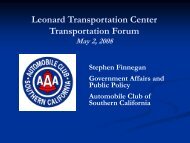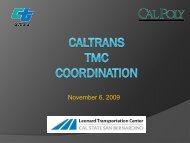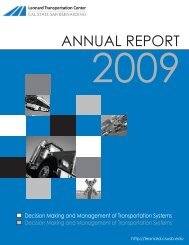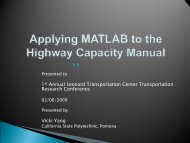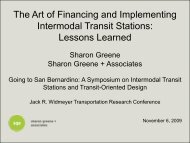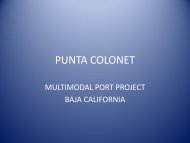Preliminaries to a Feasibility Analysis of the Maglev Proposal of The ...
Preliminaries to a Feasibility Analysis of the Maglev Proposal of The ...
Preliminaries to a Feasibility Analysis of the Maglev Proposal of The ...
You also want an ePaper? Increase the reach of your titles
YUMPU automatically turns print PDFs into web optimized ePapers that Google loves.
Literature on High Speed Rail<br />
<strong>The</strong> literature reveals certain general findings about high speed rail:<br />
• <strong>The</strong>re is usually a significant difference between maximum experimental speed and maximum<br />
operating speed. <strong>The</strong> latter is what should be applied in planning for high speed rail<br />
• Increasing maximum speed has decreasing marginal gains in travel time savings. <strong>The</strong> lesson is<br />
not <strong>to</strong> seek <strong>the</strong> highest possible speed for a new system being planned, but one that would<br />
enable significant improvement from existing operations.<br />
• Travel time reductions due <strong>to</strong> higher speed depend very much on <strong>the</strong> length <strong>of</strong> <strong>the</strong> run<br />
between stations. <strong>The</strong> lesson is <strong>to</strong> seek high speed systems for long distance spacing between<br />
s<strong>to</strong>ps; <strong>the</strong>y will bring little gain <strong>to</strong> short distance trips.<br />
• Marginal cost grows more than proportionally with increases in maximum speed. <strong>The</strong> lesson is<br />
not <strong>to</strong> necessarily seek <strong>the</strong> cutting edge <strong>of</strong> <strong>the</strong> technology if cost effectiveness is an objective.<br />
• High‐speed rail can play a key role in providing transportation for trips between 62 and 621<br />
miles (100 km <strong>to</strong> 1000 km) in length.<br />
Modal Comparisons<br />
Comparison <strong>of</strong> standard high speed rail and <strong>Maglev</strong> technologies revealed <strong>the</strong> following:<br />
Speed – Advancements in standard high speed rail technology in recent times have removed <strong>the</strong> higher<br />
speed advantage that <strong>Maglev</strong> previously had, making travel time differences between <strong>the</strong> two modes<br />
very small over typical spacing between stations.<br />
Interconnection – HSR holds a huge advantage over <strong>Maglev</strong> in its ability <strong>to</strong> use existing infrastructure<br />
and thus facilitate better interconnection with existing rail networks.<br />
Investment Cost – <strong>The</strong> maturity <strong>of</strong> <strong>the</strong> technology and its ability <strong>to</strong> use existing infrastructure enables<br />
HSR <strong>to</strong> be deployed at a lower investment cost than <strong>Maglev</strong>.<br />
Operating Costs – <strong>The</strong>se are not certain for <strong>Maglev</strong>, but HSR consumes less energy per comparable unit<br />
<strong>of</strong> train capacity.<br />
v



